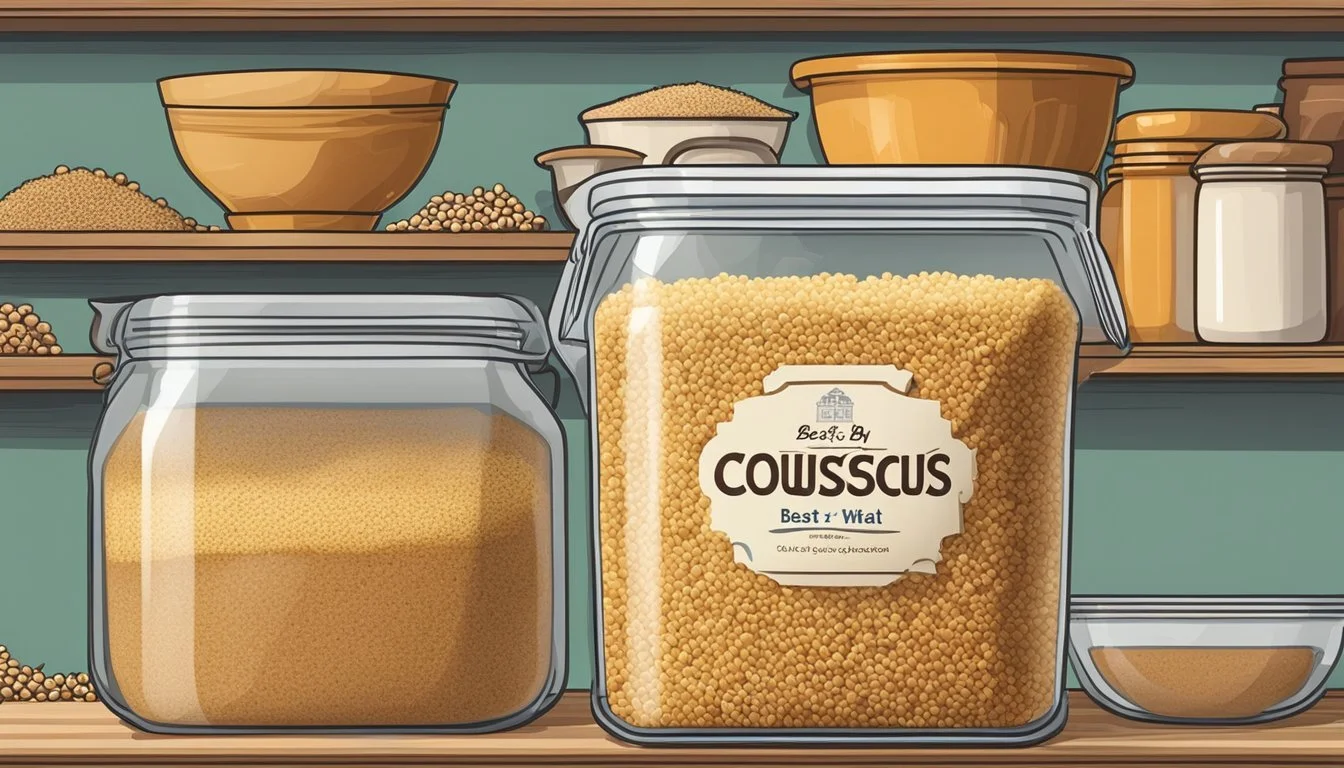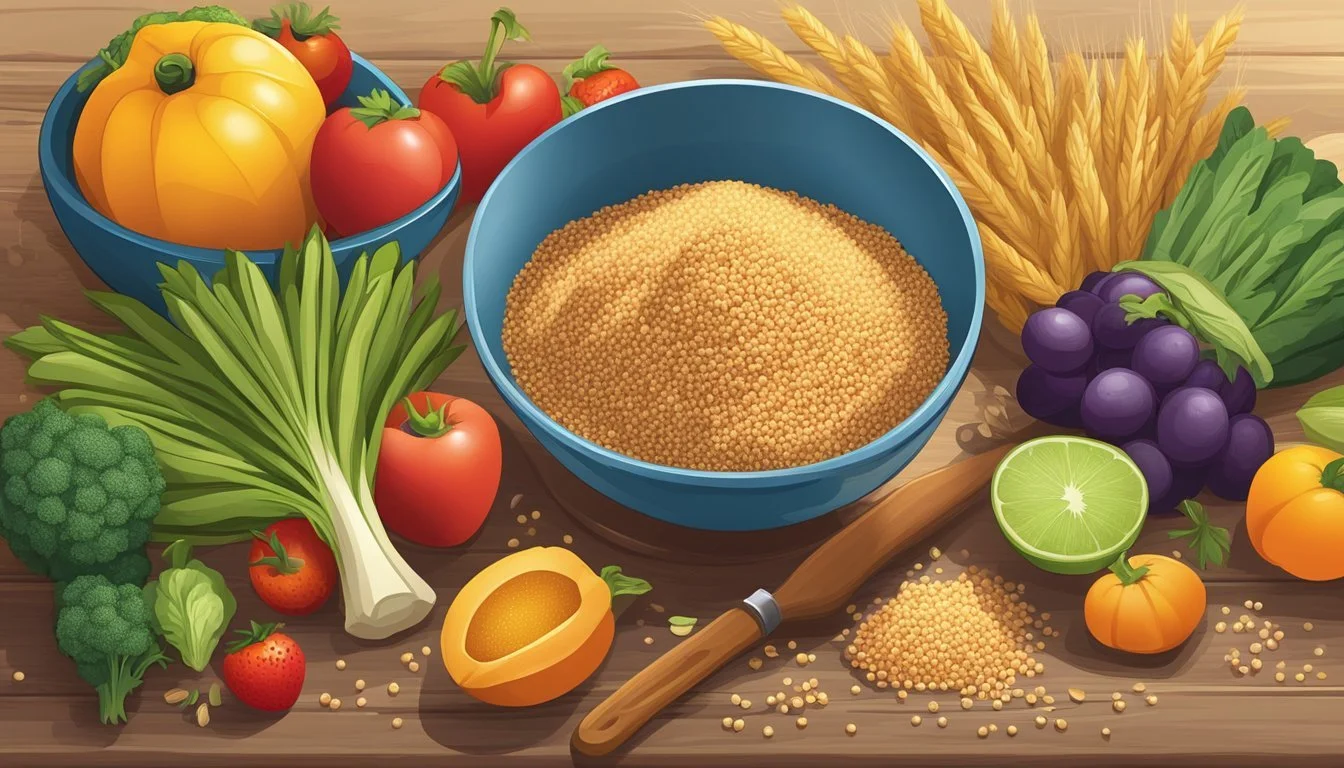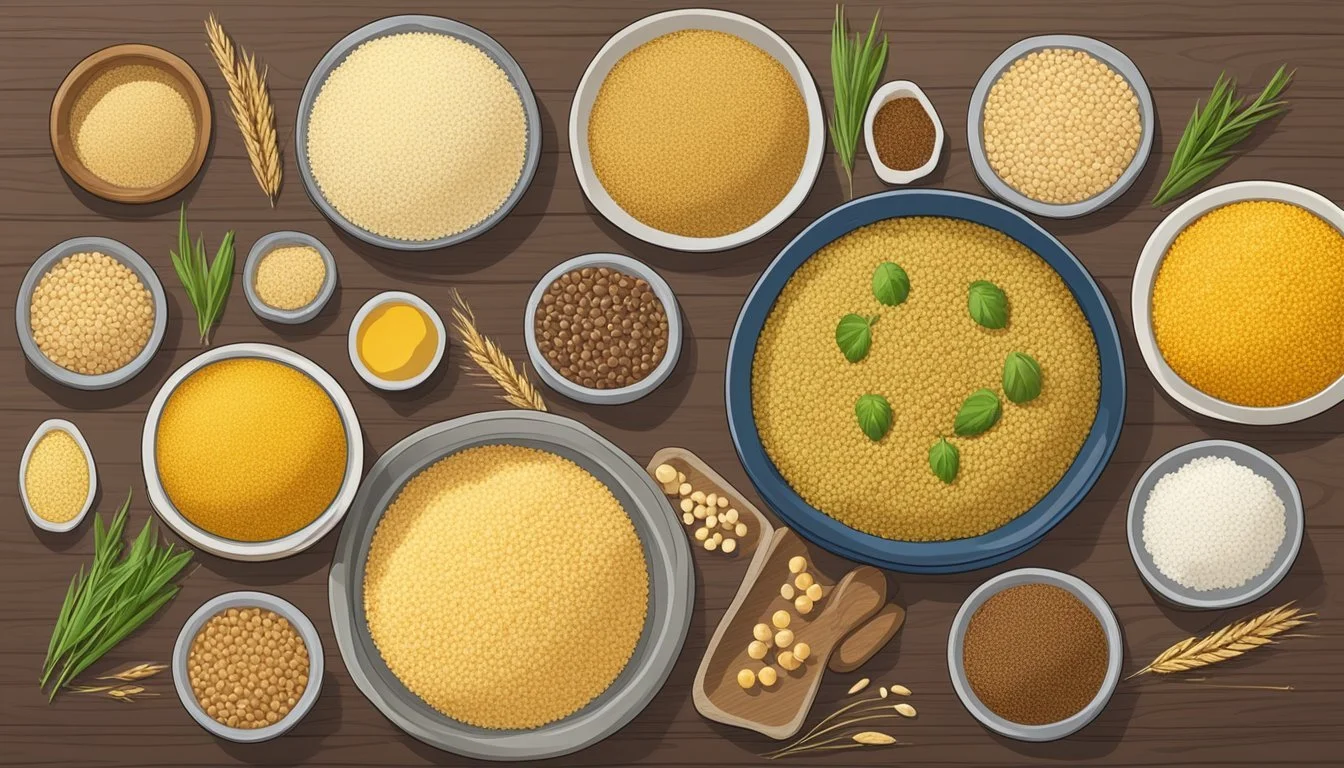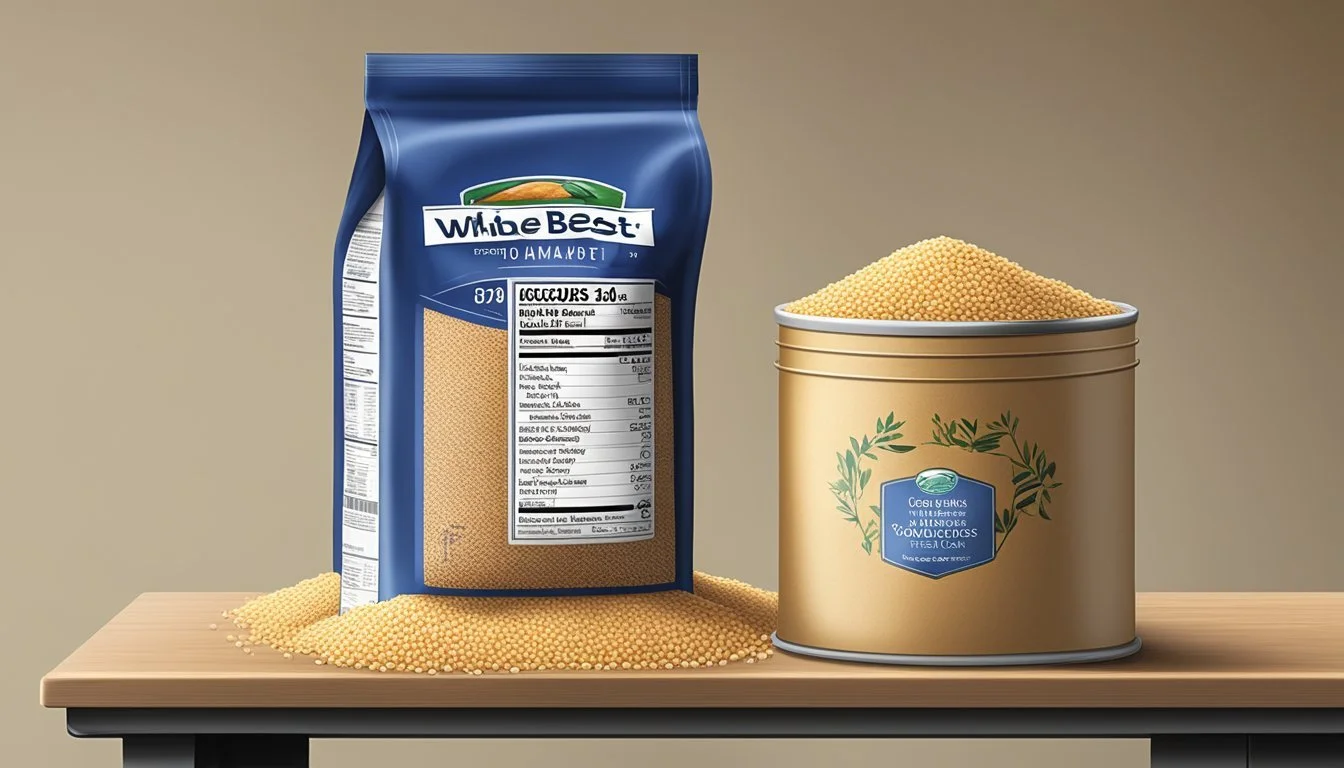How Long Does Whole Wheat Couscous Last?
Shelf Life and Storage Tips
Whole wheat couscous (What wine goes well with couscous?) is a nutritious staple that serves as an excellent source of protein and fiber, contributing to its health benefits. Like other whole grain variations, it offers more nutritional benefits than its refined counterparts, boasting a higher content of vitamins and minerals that are essential for a balanced diet.
The shelf life of whole wheat couscous is a subject of interest for both cooks and consumers seeking to maintain the freshness and quality of this grain. Uncooked whole wheat couscous can last up to six months when stored properly in a pantry, preserving its nutritional value. Cooked couscous, however, has a shorter lifespan and should ideally be consumed within a week when kept in the refrigerator to ensure both safety and taste.
Understanding the storage and lifespan of whole wheat couscous is pivotal in maximizing its culinary potential and nutritional benefits. Proper storage involves keeping it dry and shielded from heat or light, which helps prevent the fat content from going rancid and extends the grain's usability. This knowledge assists in ensuring that the whole wheat couscous consumed is not only tasty but also upholds its place as a healthy addition to meals.
What Is Whole Wheat Couscous?
Whole wheat couscous is a nutritious alternative to the traditional semolina-based grain that plays a central role in North African cuisine. It offers a higher fiber and protein content, presenting itself as a healthful choice for many.
Definition and Origin
Whole wheat couscous is made from whole durum wheat flour, rather than just the endosperm. Its origins can be traced back to North African cuisine, where it has been a staple food for centuries. Primarily, it is made by rolling whole wheat flour (how long does whole wheat flour last?) with water to form small granules that are then steamed and dried. Historically, this process was done by hand, but it has since been mechanized.
Comparison with Regular Couscous
The main difference between whole wheat couscous and regular couscous, also known as Moroccan couscous, lies in the type of flour used. Regular couscous is typically made with refined wheat flour, specifically semolina, which is just the milled endosperm of durum wheat. In contrast, whole wheat couscous retains the whole grain, including the bran, germ, and endosperm.
Texture: Whole wheat couscous usually has a coarser, nuttier flavor and a more robust texture.
Cooking time: It may take slightly longer to cook due to its denser structure.
Nutritional Profile
Whole wheat couscous is often selected for its nutritional benefits.
Fiber: It’s a good source of dietary fiber, which is beneficial for digestive health.
Protein: It provides a moderate amount of protein, essential for muscle repair and maintenance.
Nutrient Whole Wheat Couscous Regular Couscous Fiber Higher Lower Protein Higher Lower
Additionally, because it is made from whole grains, it contributes to a feeling of fullness and can aid in weight management as part of a balanced diet. Whole wheat couscous can be used in identical culinary applications to regular couscous, working well in a variety of dishes from salads to pilafs.
Culinary Uses of Couscous
Couscous serves as an adaptable staple in diverse culinary applications, thanks to its mild flavor and the ability to absorb the tastes of accompanying ingredients. This versatile grain, rich in fiber, easily incorporates into a variety of dishes ranging from simple side dishes to more complex salads and pilafs.
As a Side Dish
Couscous can be quickly prepared by steaming or soaking in hot water, creating a light and fluffy side dish. Commonly, olive oil is added to the couscous before the steaming process begins to give it a richer flavor. Once cooked, it can be enhanced with broth or a variety of spices to complement the main meal. It often features a mix of fresh herbs such as parsley or cilantro for a vibrant pop of flavor.
In Salads and Pilafs
Couscous, particularly instant couscous, is a favored base for salads and pilafs because it readily absorbs dressings and flavors from other ingredients. A couscous salad might include a colorful array of vegetables, herbs, and a tangy vinaigrette. In the creation of a pilaf, couscous could be sautéed with onions, garlic, and spices, then cooked in broth until tender, finishing with a generous handful of herbs for freshness.
Pairing with Proteins
Couscous complements a range of meats and fish, serving as an ideal backdrop to rich flavors. Hearty versions such as Lebanese couscous or pearl couscous have a larger grain size and are superb when paired with robust stews or as a bed for grilled proteins. The ability to fluff couscous after cooking ensures it maintains a pleasant texture alongside the main protein of a dish.
Proper Storage Techniques
Storing whole wheat couscous properly ensures that its quality is maintained, whether it's uncooked or cooked. The key is to protect it from moisture, heat, and light to prevent spoilage and extend its shelf life.
Storing Uncooked Couscous
Uncooked whole wheat couscous should be kept in a cool, dry place, such as a pantry. For optimal freshness, one should use an airtight container, which will protect the couscous from humidity and pests. If left in its original packaging, one should ensure that the package is resealed tightly after each use or better yet, transferred to a container that can be securely sealed.
Storing Cooked Couscous
Once cooked, couscous must be stored in a refrigerator to prevent bacterial growth. It should be cooled to room temperature before being placed in an airtight container to prevent excess moisture from being trapped inside. Properly stored, cooked couscous can last for 4 to 5 days in the fridge. For longer storage, cooked couscous can be placed in the freezer where it will maintain its quality for up to 3 months.
Shelf Life and Spoilage
When it comes to whole wheat couscous, its shelf life hinges on whether it is uncooked or cooked, and how it's stored. Understanding the optimal storage conditions and recognizing signs of spoilage can prevent food waste and safeguard against food poisoning.
Uncooked Couscous Shelf Life
Uncooked whole wheat couscous, stored properly, remains edible well past its expiration date. To maximize longevity:
Location: It should be kept in a cool, dry place, such as a pantry.
Container: An airtight container is ideal to prevent humidity and bugs.
Shelf Life: Typically, it can last for 1 to 2 years.
Cooked Couscous Shelf Life
Once cooked, whole wheat couscous requires refrigeration and has a shorter shelf life:
Temperature: Store cooked couscous in the refrigerator below 40°F.
Storage: Use an airtight container to maintain freshness.
Shelf Life: It generally keeps for 4 to 5 days.
Signs of Spoilage
Whole wheat couscous may spoil due to bacteria, mold, or improper storage. Be vigilant for:
Mold: Any visible fuzz or discoloration is a clear indication of spoilage.
Odor: An off-smell is often the first sign that cooked couscous has gone bad.
Texture: A slimy or sticky texture in cooked couscous is another warning.
Properly storing whole wheat couscous in the appropriate conditions is crucial to maintaining its quality and edibility. Taking prompt action at the first signs of spoilage is important for health and safety.
Safe Preparation Methods
Preparing whole wheat couscous safely is paramount to maintaining its high fiber content and nutty flavor. The process involves proper hydration of the dry grains and careful cooking techniques to achieve the desired fluffy texture.
Hydrating Dry Couscous
Hydrating dry couscous properly is a crucial step. They should initially boil the water in a kettle or pot. For every one cup of dry couscous, a chef usually uses about 1.5 cups of boiling water. It's common to add a pinch of salt to enhance the nuttier flavor of whole wheat couscous. After adding the couscous to the boiling water, they remove the pot from the heat source to let the grains absorb the water and swell. This step typically takes about 5 minutes, during which the couscous rehydrates under a covered pot to retain steam and heat.
Cooking & Fluffing Techniques
Once the couscous has absorbed the liquid, cooks should fluff it with a fork to separate the grains. This technique ensures a light and fluffy texture, which is the hallmark of perfectly cooked couscous. Some might incorporate an additional step to steam the rehydrated couscous over low heat, which further brings out a fluffy quality and ensures that every grain is thoroughly heated. This dual approach of absorption and steaming guarantees the couscous is safe to eat, with a consistent and enjoyable texture throughout.
Enhancing Couscous Flavor
Couscous, with its subtle taste, serves as a blank canvas for a variety of flavors. To elevate the dish, one can incorporate a medley of seasonings and vegetables tailored to personal taste or specific cuisines.
Selecting Seasonings and Herbs
When enhancing the flavor of couscous, selecting the right combination of seasonings and herbs is essential. Aromatic herbs like parsley, mint, and cilantro can impart fresh, bright notes, while spices such as cumin, paprika, and turmeric add depth and warmth. For an easy reference, consider the following table of pairings:
Herb/Spice Flavor Profile Recommended Pairings Parsley Fresh, slightly peppery Mediterranean salads Mint Cool, refreshing Lamb, peas, yogurt Cilantro Bright, citrusy Beans, avocado, lemon juice Cumin Earthy, warm Grilled meats, (What wine goes well with grilled meats?) root vegetables Paprika Sweet or smokey Chickpeas, roast chicken Turmeric Bitter, pungent Fish, cauliflower
For an aromatic touch, couscous can be cooked in broth instead of water or finished with a drizzle of olive oil.
Incorporating Vegetables and Other Additions
Couscous's versatility also allows for the addition of a wide array of vegetables, which not only enhance the flavor but also contribute to a balanced meal. Common additions can range from diced peppers and onions to grated carrots and zucchini, each bringing their unique taste and texture to the dish. Here's a simple list for quick reference:
Peppers: sweet or bell peppers for a colorful, sweet bite
Onions: sautéed for sweetness or raw for sharpness
Carrots: shredded for a hint of sweetness and crunch
Zucchini: grated or cubed for moisture and mild flavor
Additionally, one might pair couscous with salads or serve it as a base for seasoned proteins. A spritz of lemon juice before serving can brighten the entire dish, offering a citrusy counterpoint to the earthy spices like cumin, turmeric, and paprika.
Health and Nutritional Benefits
Couscous, particularly when made from whole wheat, offers a range of health and nutritional benefits. These benefits stem primarily from its dietary fiber content and the plant-based protein and other nutrients it contains.
Dietary Fiber Content
Whole wheat couscous is a good source of dietary fiber. Fiber is important for digestive health and can help to keep the digestive system running smoothly. A serving of whole wheat couscous typically contains more fiber than its refined counterpart, assisting in maintaining a healthy gut and contributing to satiety after meals.
Fiber per serving: Whole wheat couscous usually provides about 5 to 8 grams of fiber for each cooked cup.
Plant-Based Protein and Other Nutrients
In addition to fiber, whole wheat couscous is rich in plant-based protein that is beneficial for muscle repair and overall health. It also delivers a variety of nutrients that contribute to a well-rounded diet.
Protein: An approximate value of 6 grams of protein can be found in one cup of cooked whole wheat couscous.
Nutrients:
Selenium: A trace mineral important for the proper functioning of the body's antioxidant system and thyroid gland.
Nutrition: Whole wheat couscous includes a spectrum of B vitamins and minerals such as iron and magnesium.
Couscous made from whole wheat is not gluten-free, and thus, not suitable for individuals with celiac disease or gluten sensitivity. It can, however, be part of a nutritious, plant-based diet for those who do not have gluten-related disorders.
Couscous Varieties and Alternatives
Before diving into the specifics, it's essential to understand that couscous, while often lumped into one category, actually comes in several types, each with its unique characteristics and cooking methods. For those with dietary restrictions or preferences, there are also several substitutes that can mimic couscous's texture and neutral flavor in recipes.
Different Types of Couscous
Whole Wheat Couscous: This variety is made from whole wheat flour and has a nuttier flavor compared to its refined counterparts. It's a healthier option due to its higher fiber content.
Moroccan Couscous: Characterized by its tiny grains, Moroccan couscous is perhaps the most widely recognized. It's made from semolina or durum wheat flour and has a light texture.
Preparation: Can be quickly cooked in a pot or rice cooker with water or broth until fluffy.
Israeli Couscous (also known as pearl couscous): These are larger, spherical granules made from semolina and wheat flour. Israeli couscous has a chewy texture and takes a bit longer to cook.
Preparation: Best simmered slowly and can be prepared similarly to pasta. It works well in salads or as a base for hearty stews.
Lebanese Couscous (also referred to as Moghrabieh): Even larger than Israeli couscous, these pearls require soaking prior to cooking and are typically used in traditional Lebanese dishes.
Instant Couscous: A convenient option, this couscous is pre-cooked and requires just a brief soaking in hot water, making it a fast addition to meals.
Substitutes for Couscous
For those seeking alternatives, especially if gluten-free options are needed, there are several substitutes that can take the place of couscous in recipes:
Quinoa: A naturally gluten-free seed that cooks up with a fluffy texture. It's packed with protein and offers a somewhat nutty flavor.
Preparation: Rinse well before cooking and simmer in a pot or rice cooker until the seeds have sprouted tails and are tender.
Rice: Comes in many varieties, with some like jasmine or basmati having a more neutral flavor, making them suitable substitutes for couscous in terms of taste and texture.
The above options provide variety for different dietary needs and preferences while maintaining the ability to be used in a wide range of dishes, much like couscous. Whether in search of whole grain benefits or gluten-free alternatives, selections abound that don't sacrifice flavor or texture.
Troubleshooting Common Issues
This section addresses specific issues related to preparing and preserving whole wheat couscous. It focuses on avoiding commonplace errors in cooking and implementing the correct storage measures to prevent spoilage and pest infestation.
Avoiding Common Cooking Mistakes
To ensure whole wheat couscous maintains its ideal fluffy texture, it must be prepared correctly. Here are key points to remember:
Ratio: Use the correct ratio of liquid to couscous. Typically, it's a 1:1 ratio; too much liquid makes it soggy, too little will not allow it to absorb properly.
Steaming: Steam it rather than boil, as boiling can lead to clumped and mushy couscous.
Fluffing: After cooking, couscous should be fluffed with a fork to separate grains and prevent sticking.
Preventing Contamination and Pests
Storing couscous right extends its shelf life and maintains its freshness. Consider these tips for storage:
Dry Storage: Store dry couscous in a cool, dry place in an airtight container to protect it from moisture and odors that can lead to spoilage.
Refrigeration: Cooked couscous should be stored in the refrigerator in an airtight container for up to 4-5 days.
Pests: Keeping dry couscous in airtight containers protects it from pests like bugs.
To prevent mold and bacteria growth in cooked couscous, it should never be left at room temperature for extended periods. These practices keep couscous suitable for cooking and incorporation into dishes like salads and homemade couscous recipes, ensuring taste and texture are preserved.
Couscous in Culinary Cultures
Couscous occupies a revered place in culinary traditions, especially within North African cuisine. It is celebrated for its versatility as both a main course and as an integral component in a variety of dishes, such as pilafs.
Role in North African Cuisine
In the kitchens of North Africa, couscous is more than just a dried food; it's a staple of cultural identity. Moroccan couscous, a variant well-known in the region, is typically steamed and served with flavorful stews often containing vegetables and sometimes meat. In countries like Morocco, Algeria, and Tunisia, couscous is customarily enjoyed on special occasions and during routine family meals.
The preparation of couscous can be extensive, involving the steaming of the semolina grains over a simmering stew until they become fluffy and full of flavor. This technique highlights the grain's ability to absorb the spices and essences of the dish, making it a beloved centerpiece at the North African table.
Global Adaptations
The culinary world beyond North Africa embraces couscous with open arms, integrating it into various global dishes due to its ease of cooking and nutrient-rich profile. Its adaptability allows it to shift from a traditional main course in North African meals to a side dish in Western cuisine or even a foundation for creative pilafs worldwide.
From France to the United States, couscous has been adopted and adapted, showing up on menus as a base for roasted vegetables, a complement to grilled meats, or tossed in salads. This grain's mild taste and rapid cooking time encourage chefs around the globe to infuse it with local flavors, making it a versatile component that fits seamlessly into countless culinary contexts.
Conclusions and Recommendations
When considering the storage of whole wheat couscous, users should be aware that its shelf life is quite robust, mirroring that of its refined counterpart. Uncooked whole wheat couscous can be expected to maintain its quality for up to 2 years when stored in a cool, dry place, such as a pantry. To optimize freshness, it should be kept in a sealed container to prevent exposure to moisture and other contaminants.
Cooked whole wheat couscous, however, should be consumed within 4 to 5 days when stored properly in the refrigerator. It’s advisable to store it in an airtight container to safeguard against potential spoilage and flavor loss.
Users should appreciate the nutritional benefits of whole wheat couscous, which include a higher fiber content than regular couscous, as well as a source of protein. This makes it a valuable component for a balanced diet.
For those preparing whole wheat couscous, remember that due to its size and density, it might require a slightly longer cooking time than the more refined versions. They should maintain a 1:1.5 ratio of couscous to liquid to ensure proper cooking.
The flavor and versatility of whole wheat couscous make it a popular choice for a variety of dishes. Its ability to absorb the flavors of ingredients it is cooked with contributes to its widespread use across multiple cuisines.
Storage Tips for Whole Wheat Couscous - Keep uncooked couscous in a cool, dry place. - Store in a sealed container to extend shelf life. - Cooked couscous should be refrigerated in an airtight container. - Consume cooked couscous within 4-5 days.
By following these recommendations, consumers can harness the full potential of whole wheat couscous, from its health benefits to its culinary flexibility.












